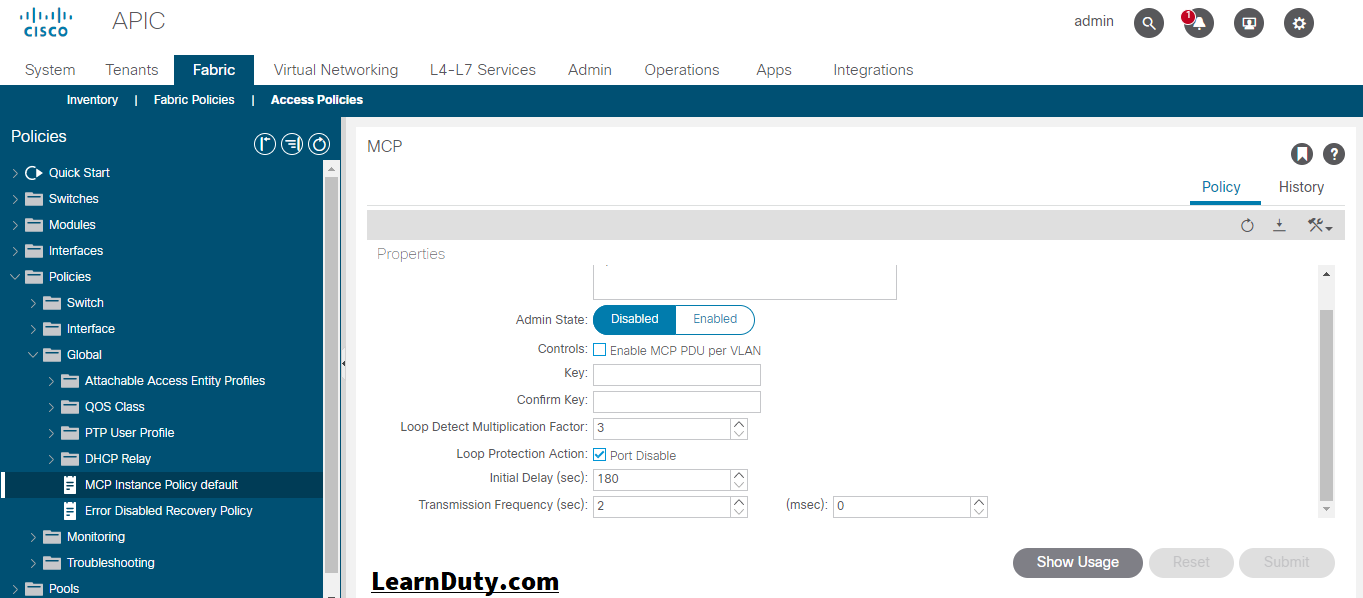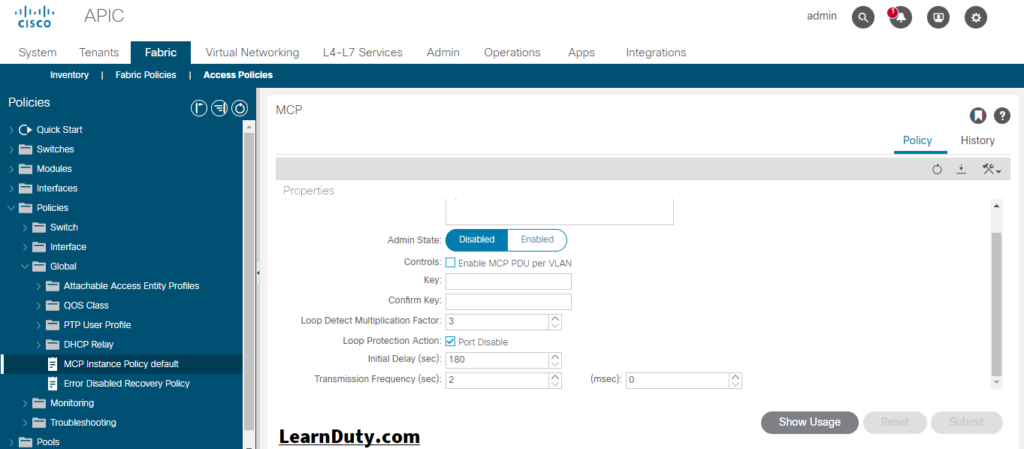MCP (MisCabling Protocol) Explained – Cisco ACI

What is MCP – MisCabling Protocol:
MisCabling Protocol (MCP) detects loops from external sources (switches or equipment running STP) and will err-disable the interface on which ACI receives its own packet or at least alert the user by displaying a fault (depends on the global MCP configuration).
Enabling this feature is a best practice, and it should be enabled globally and on all interfaces, regardless of the end device.
How MCP works:
On every EPG, MCP will send Layer-2 packets with a custom MAC address.
So for a given EPG (EPG-X), if the ACI Fabric receives an MCP packet on any interface, it will take one of these actions:
– put the interface in the error-disabled state
– Notify the user by displaying a fault.
For example: if we have 2 EPGs and both have static binding to Vlan-10. Because BPDUs are only sent over the same EPG, the Loop will not be detected in this case. the BPDU sent from the switches will not be forwarded through the ACI Fabric, which will probably cause a loop.
MCP will prevent the Loop by error disabling the interface connected to Sw-2: When the MCP packet is sent from Leaf-1, it will be received on the interface of Leaf-2. ACI will error disable the interface on Leaf-2 because MCP sent from EPG-1 is coming on EPG-2.

How to configure MCP:
By default, MCP is enabled on the interface basis, you can disable it when configuring interface policy group:

To turn on MPC globally, navigate on the APIC GUI to:
| Fabric > Access Policies > Policies > Global > MCP Instance Policy default |
By default, this protocol is disabled globally but active on all interfaces, so when enabling it, MCP will be active on all interfaces.

By default, MCP PDUs are sent on the native VLAN. In order to send MCP PDU per VLAN basis, you have
to turn on this option (check it): Controls: Enable MCP PDU per VLAN
This option allows you to configure MCP to operate in a mode where MCP PDUs are sent in all EPG VLANs that a physical port belongs to by adding 802.1Q header with each of the EPG VLAN id to the PDUs transmitted.
So, when an EPG sends an MPC Packet on an interface (tagged or on native VLAN) and the fabric receives that packet on any interface on the same leaf or any other leaf in the fabric.
Starting 3.2.1 release, the ACI fabric provides faster loop detection with transmit frequencies from 100 millisecond to 300 seconds.
Reference: cisco.com/c/en/us/td/docs/switches/datacenter/aci/apic/sw/4-x/basic-configuration/Cisco-APIC-Basic-Configuration-Guide-411/Cisco-APIC-Basic-Configuration-Guide-411_chapter_010.html
Good read as well: unofficialaciguide.com/2018/03/27/using-mcp-miscabling-protocol-for-aci/

![OSPF DR and BDR Election Explained [with Configuration]](https://learnduty.com/wp-content/uploads/2022/03/image-33.png?v=1647900046)
![OSPF Neighbor Adjacency Requirements [With Configuration]](https://learnduty.com/wp-content/uploads/2022/03/image-23-418x450.png?v=1647900064)
![BGP Route Reflector [Explained & Configuration]](https://learnduty.com/wp-content/uploads/2022/02/image-79-531x450.png?v=1647900109)
![Cisco Catalyst 9000 Switches Upgrade [Step by step]](https://learnduty.com/wp-content/uploads/2022/02/image-54.png?v=1647900155)
![L2 Interface Policy – Per Port VLAN in Cisco ACI [Explained]](https://learnduty.com/wp-content/uploads/2022/02/image-42.png?v=1647900173)